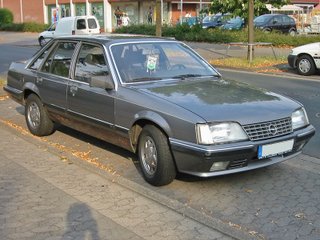
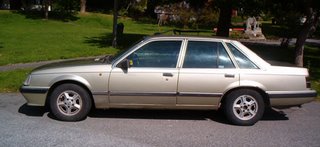
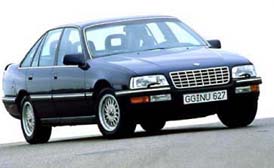
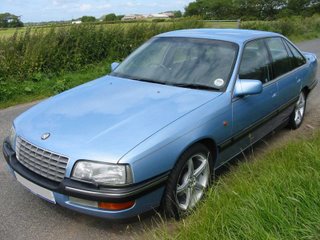
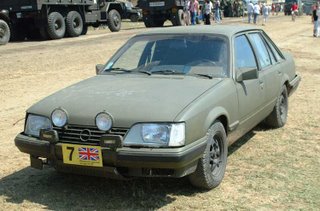
The Opel Senator was a large saloon (and derivative coupé) motor vehicle sold in Europe from 1978 until 1994. It was also known as the Chevrolet Senator, Vauxhall Royale and Vauxhall Senator. The Senator shared its platform with (first) the Opel Rekord and (later) the Opel Omega.
In coupé form, it was known as the Opel Monza and Vauxhall Royale, notable for their digital speedometer. (This Monza should not be confused with the South African Opel Monza, which was the saloon version of the smaller Kadett. To complicate things further, there also was a Chevrolet Monza in Brazil, actually a version of the 1981 German Opel Ascona with a three-door fastback body not available anywhere else.)
The Senator A was six-light, lengthened version of the Opel Rekord E, complemented by a three-door fastback coupé version on the same platform called the Opel Monza. The Senator E and Monza were initially sold in the United Kingdom as the Vauxhall Royale, as well as under their original names. The vehicle was also available in South Africa as the Chevrolet Senator, until 1982, when it was rebadged as an Opel.
In the UK, a four wheel drive conversion was available, engineered by Ferguson, who had also provided similar modifications for the Jensen Interceptor.
The original Senator and Monza were facelifted in 1982. In the UK, this model initially sold as an Opel, before being rebadged as a Vauxhall in 1984. The Monza continued to be sold as an Opel.
The Senator's general 6 window styling was also used by Holden in Australia for the Holden VK and VL Commodors between 1984 and 1988, and also formed the basis of the Daewoo Prince in South Korea.A new model, the Senator B, arrived in 1987, a long-wheelbase version of the Opel Omega (Vauxhall Carlton in the UK). There was no Monza equivalent. This model, and the Omega, formed the basis of the Holden VN Commodore in Australia, which used a stretched and widened platform.
There were various versions of the Senator B available. The 12-valve 2.5 L and 3.0 L sized engines were released in 1987 along with a luxury "CD" model with the 3.0 L engine. The CD version boasted adjustable suspension, air conditioning, heated seats, trip computer and cruise control. The cars were available with either 5-speed manual or 4-speed automatic gearboxes. Leather seats were also available as a cost option.
A 24-valve 3.0 L was introduced in 1989, generating 204 bhp (compared with 177 bhp for the older 12-valve version). This model was very popular with the police force in the UK, with several cars being supplied to upgraded police specification.[citation needed] The main feature of the new engine was a "Dual Ram" system, increasing torque at low engine speeds by means of a redirected air flow system engaged at 4,000 rpm.
Later in the model's lifespan, the 2.5 L was replaced by a 2.6 L Dual Ram, and the 3.0 L 12-valve was deleted in 1992. CD versions of the 2.6 L and 24-valve 3.0 L were available up to the model's withdrawal in 1994.
The car's main competition in this era were the Ford Scorpio (the Ford Granada in some markets), Rover 800, BMW 5-series, and Renault 25. The car's lack of a prestigious badge hampered sales, and only 26,000 units were sold in the UK during its lifespan.
When the second generation Omega was released in 1994, Opel considered that it was sufficiently represented in the upper end of the market by the top Omega MV6. Consequently, the Senator was cancelled after 1994 and not replaced with a version of the new Omega.
In coupé form, it was known as the Opel Monza and Vauxhall Royale, notable for their digital speedometer. (This Monza should not be confused with the South African Opel Monza, which was the saloon version of the smaller Kadett. To complicate things further, there also was a Chevrolet Monza in Brazil, actually a version of the 1981 German Opel Ascona with a three-door fastback body not available anywhere else.)
The Senator A was six-light, lengthened version of the Opel Rekord E, complemented by a three-door fastback coupé version on the same platform called the Opel Monza. The Senator E and Monza were initially sold in the United Kingdom as the Vauxhall Royale, as well as under their original names. The vehicle was also available in South Africa as the Chevrolet Senator, until 1982, when it was rebadged as an Opel.
In the UK, a four wheel drive conversion was available, engineered by Ferguson, who had also provided similar modifications for the Jensen Interceptor.
The original Senator and Monza were facelifted in 1982. In the UK, this model initially sold as an Opel, before being rebadged as a Vauxhall in 1984. The Monza continued to be sold as an Opel.
The Senator's general 6 window styling was also used by Holden in Australia for the Holden VK and VL Commodors between 1984 and 1988, and also formed the basis of the Daewoo Prince in South Korea.A new model, the Senator B, arrived in 1987, a long-wheelbase version of the Opel Omega (Vauxhall Carlton in the UK). There was no Monza equivalent. This model, and the Omega, formed the basis of the Holden VN Commodore in Australia, which used a stretched and widened platform.
There were various versions of the Senator B available. The 12-valve 2.5 L and 3.0 L sized engines were released in 1987 along with a luxury "CD" model with the 3.0 L engine. The CD version boasted adjustable suspension, air conditioning, heated seats, trip computer and cruise control. The cars were available with either 5-speed manual or 4-speed automatic gearboxes. Leather seats were also available as a cost option.
A 24-valve 3.0 L was introduced in 1989, generating 204 bhp (compared with 177 bhp for the older 12-valve version). This model was very popular with the police force in the UK, with several cars being supplied to upgraded police specification.[citation needed] The main feature of the new engine was a "Dual Ram" system, increasing torque at low engine speeds by means of a redirected air flow system engaged at 4,000 rpm.
Later in the model's lifespan, the 2.5 L was replaced by a 2.6 L Dual Ram, and the 3.0 L 12-valve was deleted in 1992. CD versions of the 2.6 L and 24-valve 3.0 L were available up to the model's withdrawal in 1994.
The car's main competition in this era were the Ford Scorpio (the Ford Granada in some markets), Rover 800, BMW 5-series, and Renault 25. The car's lack of a prestigious badge hampered sales, and only 26,000 units were sold in the UK during its lifespan.
When the second generation Omega was released in 1994, Opel considered that it was sufficiently represented in the upper end of the market by the top Omega MV6. Consequently, the Senator was cancelled after 1994 and not replaced with a version of the new Omega.





No comments:
Post a Comment